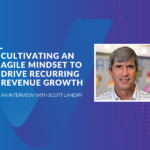Are Your Change Management Efforts Effective?
Organizations that find themselves falling behind their business goals and objectives don’t get there because of a lack of experience or scale, but rather a failure to bring their teams together; across the board, about ¾ of organizational change efforts either fail to deliver the anticipated benefits or are abandoned entirely (Harvard Business Review, 2017). Aligning your teams around your vision and facilitating their adoption through effective organizational change management is vital to the success of any transformation, and your Customer Success (CS) transformation is no exception.
Transformation is more than just a buzzword or company memo; it’s an entire cultural shift. Such radical and structural change requires an equally powerful enablement and empowerment practice. A top-down, “do as I say” approach doesn’t work when introducing new ways of working, nor does treating organizational change as an overnight exercise. For your transformation to truly take effect and have a lasting impact, you need to follow up with empathetic and effective change management processes over a period of time and continuously source feedback across your organization.
In this article, we outline 5 steps to mastering organizational change management to guarantee the success of your programs and lead a groundbreaking Customer Success transformation.
1. Determine & Communicate Your ‘Why’
When introducing an organization-wide initiative, communication is key. The goal is to drive awareness for your change effort and build a desire for that change within your team. Start by clearly outlining why the change needs to occur, what the intention of the initiative is, and the WIIFM – “What’s In It For Me.” It can be challenging to ask team members to step outside of their comfort zone and a compelling WIIFM may help you overcome this obstacle.
Change that has the potential to significantly impact your employees’ roles or lives needs to be communicated carefully and thoughtfully. Don’t spring sudden changes on your team without warning; it’s important to properly prepare them for change by dropping clues of what’s to come. For example, if a process that your Customer Success Managers (CSMs) heavily use is undergoing development and will eventually be overhauled, you can give your team hints about the incoming changes so they aren’t shocked or caught off guard. Be honest, transparent and straightforward about the full extent of the change. Communicating early and often will benefit everyone in the long run.
2. Dedicate The Right Team, Time & Resources To Enable Effective Change Management
Compliment your announcements about upcoming change with a set of clear next steps and timelines for implementation. This will ensure that your team feels reassured and confident about the new process and their role in executing it successfully. To offset potential apprehension and uncertainty, create a safety net by investing heavily in learning materials, support and educational tools so that your team has ample information and resources at their disposal. Bolster their confidence by providing them with office hours and mentors. Create a core team of internal champions; these are influential peers who can advocate for and facilitate your transformation. These champions will help develop and share best practices with the rest of your team, in addition to rallying your organization and troubleshooting any issues throughout the change journey.
3. Overcome Resistance & Struggle
Change is often accompanied by resistance. Adopting new technologies and processes brings with it a slew of emotions and creates a lot of initial heavy lifting for your team. As a leader, you will face resistance from employees throughout your change journey; don’t make the grave mistake of ignoring this feedback – listen carefully, and take considerate action. Resistance sometimes indicates a gap in your process design or rollout plan that you need to immediately resolve in order to continue your change journey. Sometimes, resistance can also highlight struggles that team members are experiencing in their adoption of the new process, which may require further assistance, support and education to get them back on track.
4. Celebrate Wins
One of the most effective strategies in driving change within Customer Success is highlighting wins. By celebrating successes, you’ll reinforce positive change and demonstrate what good looks like. This reinforcement ensures that those responsible for the positive behavior are encouraged to continue down that path and motivates others that haven’t yet adopted the change.
Gamification is another way to encourage behavior shifts and accelerate laggards as well. Something as simple as a leaderboard or weekly progress update can light a fire under folks and help them stay accountable. If the change impacts a larger group, setting aggressive targets and offering a reward if the whole team hits the mark can help further motivate folks (and apply gentle peer pressure to boot!).
5. Collect Feedback & Measure Your Impact
Rolling out your change is just the beginning – you should strive for continuous improvement. Perform regular check-ins and collect feedback to measure progress. Be sure to routinely consult your champion network to gauge employee sentiment since they’ll have first hand knowledge, and a deeper understanding, of employee attitudes. By creating a thorough feedback loop throughout your change journey and at specific milestones, you can generate insights into where further employee development is needed and spot any gaps or opportunities in your rollout plan or your Customer Success transformation.
Lead For Change With Empathy & Effect
At the end of the day, change takes time. Even if the new process or tool is better than the old, I always say that people hate change and the way things are in that order, and it’s absolutely true. To ensure your new change takes hold, remember that offering opportunities for people to learn in different ways, test their learning and be held accountable to take action will help accelerate the process. If you can lead with patience and empathy, communicate openly (which includes active listening!) and provide plenty of support, you will achieve more than your goals, you’ll master organizational change management!
A happy, engaged and motivated team is the crux of your business’ and your customers’ success. Discover 6 data-driven ways you can drive an exceptional employee experience and accelerate your success.





